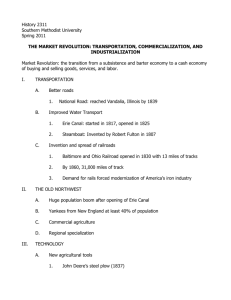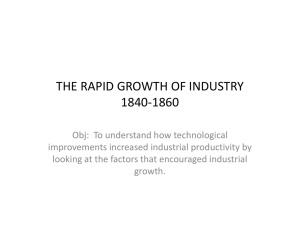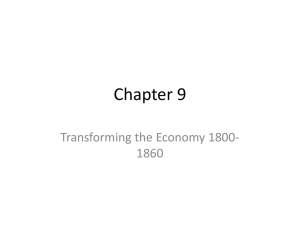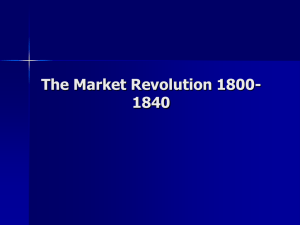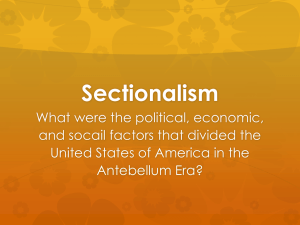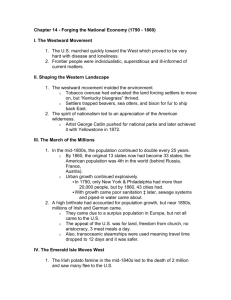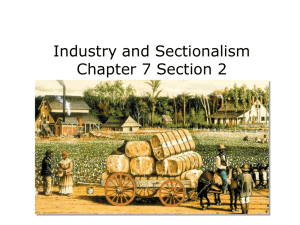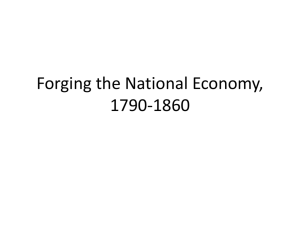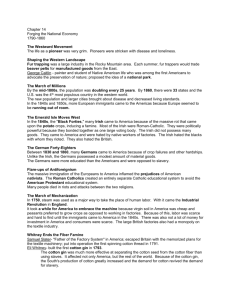Forging the National Economy
advertisement
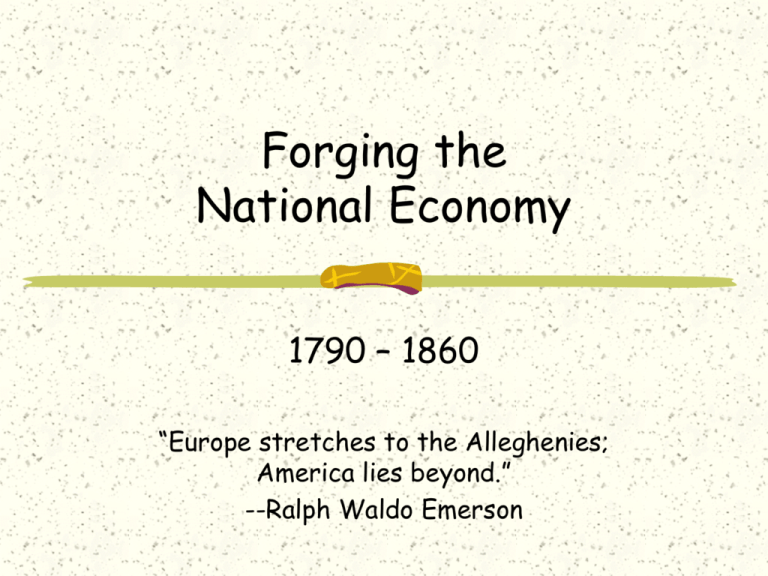
Forging the National Economy 1790 – 1860 “Europe stretches to the Alleghenies; America lies beyond.” --Ralph Waldo Emerson The Westward Movement US marched quickly toward the West Very hard – disease & loneliness Frontier people were individualistic, superstitions, & ill-informed Shaping the Western Landscape Westward movement molded environment Tobacco exhausted land Kentucky blue grass thrived Ecological imperialism – exploitation of the land Trapped beavers, sea otters, and bison to manufacture for East Spirit of nationalism - appreciation of American wilderness George Catlin pushed for national park Yellowstone in 1872 The March of the Millions Population doubled every 25 years 1860 - 4th largest in the world High birthrate German & Irish immigrants Transoceanic steamship – reduced travel to 12 days 1860 – 33 states Urban growth exploded Bad sanitation resulted in: sewage system – Boston 1823 pipe-in water supply – NY 1842 Irish Immigrants Potato famine (1840s) 2 million died & many fled to US Settled in large cities - Boston & NY Many were illiterate Discriminated against(NINA) Low-paying jobs (railroad) Religiously discriminated against - Catholic Competed with blacks for jobs Ancient Order of Hibernians - aided Irish Attracted to politics & police dept. The German Forty-Eighters 1830-1860 – 1 million arrived Crop failures & democratic revolution of 1848 Had more money than Irish Bought land in Wisconsin Wooed by politicians Contributed to US culture Isolationism Urged public education & freedom of slaves Some resentment settled in groups Brought beers Antiforeignism Nativists – against immigrants Jobs, politics, & religion 1840s – Catholics started their own schools Order of the Star-Spangled Banner 1849 – “Know-Nothing Party” Antiforeignism • “Know-Nothing” Party - Met in secrecy Fought for restriction on immigration, naturalization, & deportation of aliens Wrote books about corruption of churches Violence erupted Philadelphia 1844 – burned churches, schools, people killed Made America a pluralistic society Immigrants became crucial to economic expansion The March of Mechanization Industrial Revolution spread to US US became an industrial giant Land was cheap, labor scarce, money for investment plentiful, raw materials Lacked consumer factory-scale manufacturing Competed with British factories British kept textile to own monopoly Forbade travel of craftsmen & export of machines US remained rural Samuel Slater “Father of the Factory System” Learned machinery in Britain & escaped to US with knowledge Built 1st cotton thread spinner in the United States - 1791 Aided by Moses Brown Eli Whitney Cotton gin Cotton economy now profitable, saved “King Cotton” South flourished & expanded cotton kingdom toward west North factories manufactured cotton Interchangeable Parts – 1850 Marvels in Manufacturing Embargo (War of 1812) encouraged home manufacturing American factories closed after the war British poured in cheap goods Tariff of 1816 – protect US economy Principle of “limited liability” stimulate economy Laws of “free incorporation” – 1848 No longer need to apply for charter to start corporation Improvements Inventions: Elias Howe & Isaac Singer Sewing machine – 1846 Samuel Morse Telegraph- connected business 28,000 patents applied for by Civil War. Workers & Wage Slaves Conditions: Impersonal relations Long hours, low wages No unions Child labor Harsh working conditions Conditions improved in 1820s-1830s 10 hour day (Van Buren) More money Tolerable conditions Public education Ban on imprisonment for debt Unions Many workers tried to strike but lost Immigrants replaced workers 1830s – Unions formed but hit hard by the Panic of 1837 Commonwealth v. Hunt (1842) – Mass Legalized unions on peaceful & honorable protest Women & the Economy Factory work / bad conditions Lowell Girls Opportunities rare Mainly domestic service, teaching, & nursing Single women worked, married women were house-wives Cult of domesticity Family More marriages for love Average family size decreased Domestic feminism Child-centered families Western Farmers Trans-Allegheny region (Ohio-Indiana-Illinois) became nation’s breadbasket Planted corn & raised hogs Inventions John Deere – steel plow Cyrus McCormick – mechanical mower-reaper Led to large-scale production Produced more than the south Need for better transportation Highways & Steamboats Improvements in transportation: Lancaster Turnpike (Lancaster to Philadelphia) Brought economic expansion to West Cumberland Road (Maryland to Illinois) 1811-1852 Paid for with state & federal money Robert Fulton - Steam Engine – 1807 Increased US trade Contributed to development of South & West “Clinton’s Big Ditch” Erie Canal – NY (1817-1925) Between Lake Erie & Hudson River Impact: Shorten expense & time Cities grew along the canal Cost of food reduced Farms became specialized to be able to compete for prices Pioneer Railroad Promoters 1828 – 1st railroad in US 1860 – 30,000 miles of tracks (3/4 in north) – why is this going to be important? Railroad was opposed because of fear that the Erie Canal would lose money & fire (very dangerous) Trains were badly constructed (brakes bad) & gauge of traveling varied – what does this mean? The Transport Web NY became the Queen port Division of labor Each region specialized in own economy activity South-cotton to New England West-grain & livestock for East & Europe East-machines, textiles for South & West Transformed home Once center of economy but now a refuge (cult of domesticity again!) Wealth & Poverty Wide gap between rich & poor Greatest extreme in the cities Unskilled workers were drifters Some social mobility existed Rags-to-riches were rare Standard of living increased Wages increased Exports Foreign export Cotton –1/2 of all exports After repeal of Corn Law of 1846, wheat became important role in trade with England Americans imported more than exported Substantial debt to foreign creditors Cables, Clippers, & Pony Riders 1858 – Cyrus Field laid telegraph cable between US & Europe Better one in 1866 1840s-1850s – Donald McKay built clipper ships Faster & longer Sacrificed cargo space for speed Crushed by British’s iron tramp steamers 1860 – Pony Express Speedy communication from Missouri to CA
